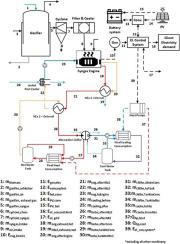当前位置:
X-MOL 学术
›
Energy Convers. Manag.
›
论文详情
Our official English website, www.x-mol.net, welcomes your
feedback! (Note: you will need to create a separate account there.)
A techno-economic optimization model of a biomass-based CCHP/heat pump system under evolving climate conditions
Energy Conversion and Management ( IF 9.9 ) Pub Date : 2020-11-01 , DOI: 10.1016/j.enconman.2020.113256 Moritz Wegener , Anders Malmquist , Antonio Isalgue , Andrew Martin , Pol Arranz , Oscar Camara , Enrique Velo
Energy Conversion and Management ( IF 9.9 ) Pub Date : 2020-11-01 , DOI: 10.1016/j.enconman.2020.113256 Moritz Wegener , Anders Malmquist , Antonio Isalgue , Andrew Martin , Pol Arranz , Oscar Camara , Enrique Velo

|
Abstract An innovative modelling approach for the design of biomass-based, solar-assisted combined cooling, heating, and power (CCHP) and heat pump (HP) systems for various climate scenarios is proposed in this work. The modelling approach is comprised of three sub-models (a demand sub-model, a supply sub-model, an economic sub-model) allowing for cost-optimal sizing of the system components based on net present cost (NPC). Subsequently a transient optimization model has been developed, which computes the technical and economic performance for each component size and for each ambient temperature of the different climate scenarios. Additionally, the model provides data on energy efficiency, exergy efficiency, and CO2-emissions of a given CCHP/HP system. The model has then been employed in a case study in order to analyse the performance of a CCHP/HP system for a tourist, museum, and guest accommodation structure located at the Montjuic castle in Barcelona, Spain. The results show that the smallest simulated biomass-based CCHP system using a 25 kWe syngas-fuelled engine would reduce lifetime costs by 7% compared to an only-HP system while operating with a high total energy efficiency of over 60%. The combined CCHP/HP system would operate with an exergy efficiency of 18%. However, larger CCHP systems cannot offset the much higher capital costs despite increasing electricity sales. The findings also reveal that for the high climate change scenario the overall project costs drop by up to 2.5%, however the effects have little impact on the optimal CCHP/HP system sizing. Even the smallest CCHP system would reduce emissions already by 75% with an increasing trend for larger systems. Although CCHP/HP systems would lead to lower NPC and emissions, the high investment costs and the complexity of the combined system remain considerable obstacles.
中文翻译:

气候变化条件下生物质热电联产/热泵系统的技术经济优化模型
摘要 在这项工作中,提出了一种创新的建模方法,用于设计基于生物质的、太阳能辅助的冷热电联供 (CCHP) 和热泵 (HP) 系统,用于各种气候情景。建模方法由三个子模型(需求子模型、供应子模型、经济子模型)组成,允许基于净现值 (NPC) 对系统组件进行成本优化。随后开发了一个瞬态优化模型,该模型计算每个组件尺寸和不同气候场景的每个环境温度的技术和经济性能。此外,该模型还提供给定 CCHP/HP 系统的能源效率、火用效率和 CO2 排放数据。该模型随后被用于案例研究,以分析位于西班牙巴塞罗那 Montjuic 城堡的旅游、博物馆和宾客住宿结构的 CCHP/HP 系统的性能。结果表明,与仅使用 HP 系统相比,使用 25 kWe 合成气燃料发动机的最小模拟生物质 CCHP 系统将降低 7% 的生命周期成本,同时以超过 60% 的高总能效运行。联合 CCHP/HP 系统将以 18% 的火用效率运行。然而,尽管电力销售增加,但更大的 CCHP 系统无法抵消更高的资本成本。研究结果还表明,对于高气候变化情景,整体项目成本下降高达 2.5%,但这种影响对最佳 CCHP/HP 系统规模影响不大。即使是最小的 CCHP 系统也将减少 75% 的排放量,而更大的系统有增加的趋势。尽管 CCHP/HP 系统会导致更低的 NPC 和排放,但高投资成本和组合系统的复杂性仍然是相当大的障碍。
更新日期:2020-11-01
中文翻译:

气候变化条件下生物质热电联产/热泵系统的技术经济优化模型
摘要 在这项工作中,提出了一种创新的建模方法,用于设计基于生物质的、太阳能辅助的冷热电联供 (CCHP) 和热泵 (HP) 系统,用于各种气候情景。建模方法由三个子模型(需求子模型、供应子模型、经济子模型)组成,允许基于净现值 (NPC) 对系统组件进行成本优化。随后开发了一个瞬态优化模型,该模型计算每个组件尺寸和不同气候场景的每个环境温度的技术和经济性能。此外,该模型还提供给定 CCHP/HP 系统的能源效率、火用效率和 CO2 排放数据。该模型随后被用于案例研究,以分析位于西班牙巴塞罗那 Montjuic 城堡的旅游、博物馆和宾客住宿结构的 CCHP/HP 系统的性能。结果表明,与仅使用 HP 系统相比,使用 25 kWe 合成气燃料发动机的最小模拟生物质 CCHP 系统将降低 7% 的生命周期成本,同时以超过 60% 的高总能效运行。联合 CCHP/HP 系统将以 18% 的火用效率运行。然而,尽管电力销售增加,但更大的 CCHP 系统无法抵消更高的资本成本。研究结果还表明,对于高气候变化情景,整体项目成本下降高达 2.5%,但这种影响对最佳 CCHP/HP 系统规模影响不大。即使是最小的 CCHP 系统也将减少 75% 的排放量,而更大的系统有增加的趋势。尽管 CCHP/HP 系统会导致更低的 NPC 和排放,但高投资成本和组合系统的复杂性仍然是相当大的障碍。











































 京公网安备 11010802027423号
京公网安备 11010802027423号